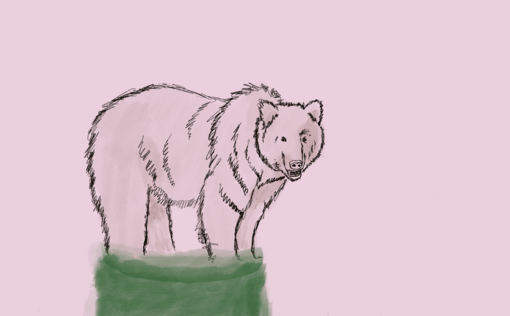
Drawing by Nathaniel St. Clair
Grizzly bears indisputably create challenges for those of us privileged to live among them. Our food is their food. Grizzlies are also among the largest of large carnivores in North America. Because of their size and sometimes aggressive defense of personal space they can be dangerous, enough so to have killed around 70 people since the turn of the previous century. And they are, indeed, showing up more often in our backyards, pastures and fields.
But that is only part of the story.
We humans are far more lethal to grizzly bears than they ever will be to us. Between 80-90% of all the adolescent and adult bears that die do so because a human kills them, amounting to a human-caused toll of nearly a thousand bears since the mid-1970s. By contrast, the odds of any one of us being mauled, much less killed, by a grizzly during a close encounter are trivially small, somewhere around 3 to 6 out of 1,000 — about the same as me being savaged by a squirrel in my yard.
Moreover, in contrast to the comparative trickle of grizzly bears into what we consider our back yards, we humans are a veritable tsunami overrunning their wildlands. As anyone knows who has been around northwestern Montana for even the last 10 years, ever more land is being gobbled up by residential developments that intrude on previously wild country. The associated influx of people has spawned ever more day hikers, mountain bikers and traffic, along with a burgeoning of domestic animals, fruit trees, lawns, and garbage that attract bears to the places we live. Anymore, the Flathead Valley and Missoula environs are a veritable wall of lethal humanity.
But the plains and into the valleys. The official mantra is that mounting numbers of bears have saturated carrying capacity in the backcountry, impelling them outward onto the peripheries of historical range. Buried in this narrative are the assumptions that increases in distribution have been proportional to increases in bear numbers and, moreover, that carrying capacity is static.
Neither is true. Increases in bear distributions in the Northern Continental Divide and Greater Yellowstone have far outstripped even the most optimistic estimates of population growth. And carrying capacity is not static. Notably, important bear foods have been lost and habitats destabilized by rapidly changing environments and climates. Whitebark pine is functionally gone as a bear food, at the same time that transient unproductive habitats have spread in the aftermath of escalating wildfires.
Meanwhile, the cattle that are drawing bears ever farther out from the Rocky Mountain Front have reached near record numbers since low ebb a decade before. Compounding all of this, berry famines drive spikes in grizzly bear mortalities that foreshadow what will happen if, as projected, berry-producing shrubs and their pollinators are devastated by human-caused changes to the environment. In other words, habitat matters.
The world is not static for grizzly bears. In fact, they are probably under more duress now than they have been for decades. Grizzly bears are not the problem. We are the problem. One-sided stories that lack context will only make it more difficult to grapple with the challenges and complexities of living with grizzlies.